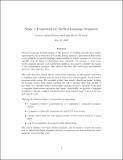| dc.contributor.advisor | Boris Katz | |
| dc.contributor.author | Marton, Gregory Adam | en_US |
| dc.contributor.author | Westrick, Linda Brown | en_US |
| dc.contributor.other | Infolab | en_US |
| dc.date.accessioned | 2009-05-28T19:00:05Z | |
| dc.date.available | 2009-05-28T19:00:05Z | |
| dc.date.issued | 2009-05-28 | |
| dc.identifier.uri | http://hdl.handle.net/1721.1/45548 | |
| dc.description | Source code and technical description | en_US |
| dc.description.abstract | To help explore linguistic semantics in the context of computational natural language understanding, Sepia provides a realization the central theoretical idea of categorial grammar: linking words and phrases to compositional lambda semantics. The Sepia framework provides a language in
which to express complex transformations from text to data structures, and tools surrounding that language for parsing and machine learning. Lambda semantics are expressed as arbitrary Scheme programs, unlimited in the semantic representations they may build, and the rules for transformation are expressed in Combinatory Categorial Grammar, though the details of grammar formalism may be easily changed. This report explains the major design decisions, and is meant to teach the reader how to understand Sepia semantics and how to create lexical items for a new language understanding task. | en_US |
| dc.format.extent | 25 p. | en_US |
| dc.rights | Creative Commons Attribution-Share Alike 3.0 Unported | en_US |
| dc.rights.uri | http://creativecommons.org/licenses/by-sa/3.0/ | |
| dc.title | Sepia: a Framework for Natural Language Semantics | en_US |
